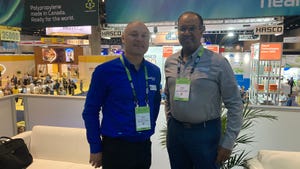Moisture-shrinkable Film Could Create Value-added Markets
March 31, 2003
Kimberly-Clark Worldwide Inc., a division of personal-care products company Kimberly-Clark, Dallas, TX, is licensing a water-shrinkable film technology that could overcome problems of heat-induced shrink wrap in temperature-sensitive applications. Blown and cast films can be produced, and processors can tailor the level of shrinkage (up to 40%) in the machine or transverse direction, or both. Film structural changes are permanent.
The film technology is patented in the U.S. (5,641,562). Kimberly-Clark formulated a number of two-component material blends consisting of an elastomeric polymer and a water-dispersible resin, and various combinations control the degree of shrinkage. Jason Lye, licensing associate for Kimberly-Clark’s global technology transfer group, Roswell, GA, says that by selectively choosing the two polymers, films can resist shrinkage in aqueous solutions at low pH values, but shrink when above a critical pH. Such films could be used in drug-release systems.
Potential water-dispersible polymers include hydroxypropyl cellulose, polyethylene oxide, polyvinyl alcohol, polyvinyl pyrolidone, polyvinyl pyridine, nylon copolymer, polyacrylic acid, and gelatinized starch. The elastomeric element could be styrene-butadiene copolymer, polychloroprene, nylon copolymer, segmented polyurethane, ethylene-vinyl acetate copolymer, and natural or synthetic rubber.
Licensees are being sought through Web-based technology transfer company yet2.com. Opportunities in value-added films for niche applications are seen. A number of potential end-uses include healthcare and food packaging, and moisture-activated gaskets for home and industrial applications. For example, the film could function as a visual alarm when electronic or mechanical switching systems have been exposed to high levels of moisture.
The polymer blends process normally on traditional blown film and cast film equipment. Extrusion imparts a degree of tension to the elastomeric component. This tension is locked in and maintained by the water-dispersible polymer. Upon immersion in water or aqueous fluids, the water-dispersible polymer dissolves, releasing the tension of the elastomeric component and causing asymmetrical or bi-directional shrinkage.
“The percentage of shrinkage and direction are controlled by cold-drawing of the film after processing,” says Lye. “The thinner the film, the more rapidly it responds to moisture.” The film is translucent and low-gloss when extruded and becomes opaque after stretching. Films can be uniaxial or biaxially-oriented. During trials, monolayer films of various thicknesses that could be laminated to other films were produced.
The web exhibits adequate strength during use but loses its integrity when moisture triggers shrinkage. Lye doesn’t believe high humidity will cause premature film shrinkage, although validation trials will be needed to determine the shelf lives of specific end products.
Kimberly-Clark developed the technology in the mid-1990s while studying fundamental properties of film blends under various processing conditions. Although the company has not put a price on the shrinkable films, Lye says end-product costs will probably depend on the polymers selected and the derived end-use advantages.
You May Also Like


